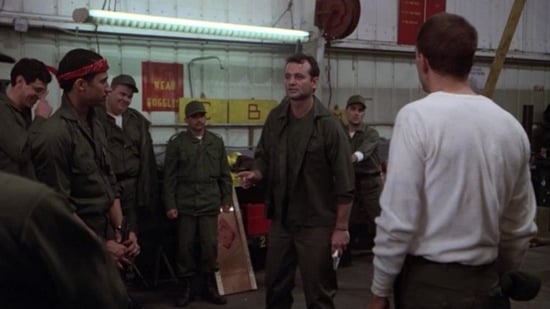Shocking Blocking (17)
By:
May 19, 2011

Bill Murray’s ironic snark presents us with an object lesson regarding the deviousness of Middlebrow. (Same goes for the snark of Murray’s fellow Saturday Night Live alumni Dan Aykroyd and Chevy Chase; also Steve Martin.) On SNL, and in such movies as Stripes, Ghostbusters, and Groundhog Day, Murray’s dedication to the snarky put-on is supposed to identify him as a nobrow figure. But are Murray’s best-loved characters truly disaffected? When they swing, do they hang past right and wrong? No — the only Murray characters who can be described this way are adultescents and/or crazy (Carl in Caddyshack, Bob in What About Bob?, Todd in the “Nerds” sketches), all of whom we’re discouraged from taking seriously. His career-resuscitating association with Wes Anderson (particularly The Life Aquatic With Steve Zissou), Sofia Coppola, and Jim Jarmusch has revealed something sinister that we should have seen all along: Murray isn’t nobrow; he’s an avatar of Quatsch— which, like Murray himself, is a middlebrow sheep in nobrow wolf’s clothing. In the tableau vivant from Stripes shown here, Murray’s character uses nobrow wiles to gull lowbrows (e.g., John Candy, third from left) into swallowing sentimental pabulum: “We’re Americans, with a capital ‘A,’ huh? […] We’re all very, very different — but there’s one thing that we all have in common. We were all stupid enough to enlist in the Army,” etc., etc. Note that Harold Ramis’ nobrow character, snickering at far left, isn’t buying it.
An occasional series analyzing some of the author’s favorite moments in the positioning or movement of actors in a movie.
THIRTIES (1934–1943): It Happened One Night (1934) | The Man Who Knew Too Much (1934) | The Guv’nor (1935) | The 39 Steps (1935) | Young and Innocent (1937) | The Lady Vanishes (1938) | Mr. Smith Goes to Washington (1939) | The Big Sleep (1939) | The Little Princess (1939) | Gone With the Wind (1939) | His Girl Friday (1940)
FORTIES (1944–1953): The Diary of a Chambermaid (1946) | The Asphalt Jungle (1950) | The African Queen (1951)
FIFTIES (1954–1963): A Bucket of Blood (1959) | Beach Party (1963)
SIXTIES (1964–1973): For Those Who Think Young (1964) | Thunderball (1965) | Clambake (1967) | Bonnie and Clyde (1967) | Madigan (1968) | Wild in the Streets (1968) | Barbarella (1968) | Harold and Maude (1971) | The Mack (1973) | The Long Goodbye (1973)
SEVENTIES (1974–1983): Les Valseuses (1974) | Eraserhead (1976) | The Bad News Bears (1976) | Breaking Away (1979) | Rock’n’Roll High School (1979) | Escape from Alcatraz (1979) | Apocalypse Now (1979) | Caddyshack (1980) | Stripes (1981) | Blade Runner (1982) | Tender Mercies (1983) | Monty Python’s The Meaning of Life (1983)
EIGHTIES (1984–1993): Repo Man (1984) | Buckaroo Banzai (1984) | Raising Arizona (1987) | RoboCop (1987) | Goodfellas (1990) | Candyman (1992) | Dazed and Confused (1993) |
NINETIES (1994–2003): Pulp Fiction (1994) | The Fifth Element (1997)
OUGHTS (2004–13): Nacho Libre (2006) | District 9 (2009)
READ MORE essays by Joshua Glenn, originally published in: THE BAFFLER | BOSTON GLOBE IDEAS | BRAINIAC | CABINET | FEED | HERMENAUT | HILOBROW | HILOBROW: GENERATIONS | HILOBROW: RADIUM AGE SCIENCE FICTION | HILOBROW: SHOCKING BLOCKING | THE IDLER | IO9 | N+1 | NEW YORK TIMES BOOK REVIEW | SEMIONAUT | SLATE
Joshua Glenn’s books include UNBORED: THE ESSENTIAL FIELD GUIDE TO SERIOUS FUN (with Elizabeth Foy Larsen); and SIGNIFICANT OBJECTS: 100 EXTRAORDINARY STORIES ABOUT ORDINARY THINGS (with Rob Walker).
